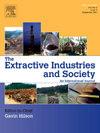儿童想象中的煤矿景观未来:以绘图为研究工具进行后开采土地利用规划
IF 4.3
2区 社会学
Q2 ENVIRONMENTAL STUDIES
Extractive Industries and Society-An International Journal
Pub Date : 2025-09-25
DOI:10.1016/j.exis.2025.101785
引用次数: 0
摘要
矿业后景观恢复是一项全球性的挑战,涉及诸多难题,引发土地利用冲突。虽然强调了自然继承的潜力和参与性规划的重要性,但在决策过程中仍然没有听取地方利益攸关方,特别是年轻一代的声音。本研究通过探索生活在大型露天煤矿附近的6-12岁儿童如何设想景观的未来,以绘画为研究方法,解决了这一差距。基于对46张图片的视觉内容分析,我们研究了儿童偏好的多样性及其与成人导向计划的一致性。这些图片揭示了广泛的想法,从低干预的自然景观到以水上公园或住房开发为特色的高度人为设计。统计数据显示,年龄较小的孩子和年龄较大的孩子之间存在显著差异,年龄较大的孩子更喜欢自然景观。儿童的视野受到现有当地特色的影响,但也表达了超越传统规划框架的富有想象力的替代方案。该研究显示了使用绘图绘制空间感知地图的方法价值,并强调了儿童有意义地参与采矿后土地使用的潜力,因此,规划人员不应将儿童的想法视为不切实际而予以忽视,而应认为他们的贡献是合法和有见地的。本文章由计算机程序翻译,如有差异,请以英文原文为准。
The future of coal mining landscape in children´s imagination: Using drawings as a research tool in post-mining land use planning
The post-mining landscape restoration is a global challenge which involves many dilemmas and arouses land use conflicts. While the potential of natural succession and the importance of participatory planning have been emphasized, the voices of local stakeholders - particularly the young generation - remain absent from decision-making processes. This study addresses this gap by exploring how children aged 6–12 living near a large surface coal mine envision the future of landscape, using drawings as a research method. Based on visual content analysis of 46 images, we examine the diversity of children's preferences and their alignment with adult-oriented plans. The pictures reveal a wide spectrum of ideas, from low-intervention natural landscapes to highly anthropogenic designs featuring waterparks, or housing developments. Statistically significant differences were observed between younger and older children, with older ones showing a greater preference for natural landscapes. Children’s visions were influenced by existing local features yet also expressed imaginative alternatives beyond conventional planning frameworks. The study demonstrates the methodological value of using drawings to map spatial perceptions and highlights the potential for meaningful child participation in post-mining land use, thus rather than dismissing children’s ideas as unrealistic, planners should consider their contributions as legitimate and insightful.
求助全文
通过发布文献求助,成功后即可免费获取论文全文。
去求助
来源期刊

Extractive Industries and Society-An International Journal
ENVIRONMENTAL STUDIES-
CiteScore
6.60
自引率
19.40%
发文量
135
 求助内容:
求助内容: 应助结果提醒方式:
应助结果提醒方式:


